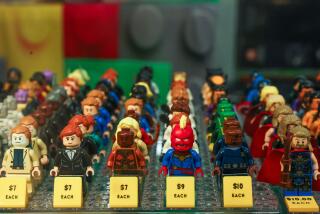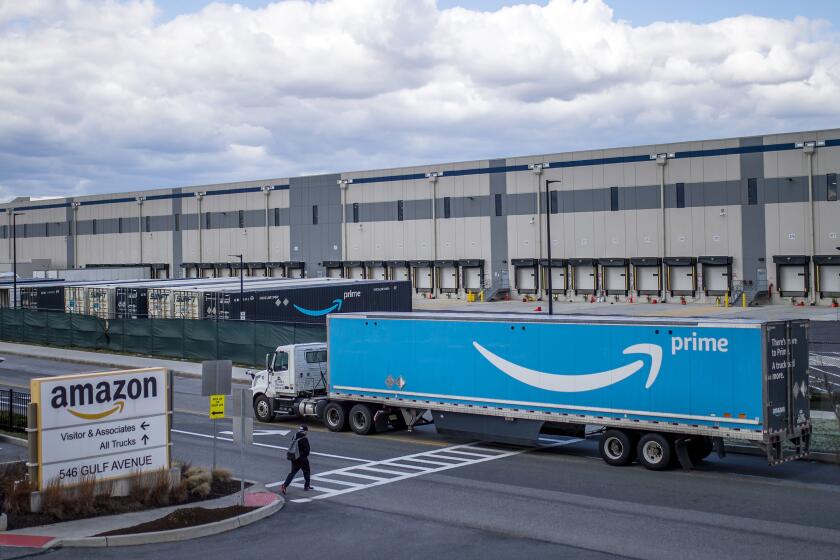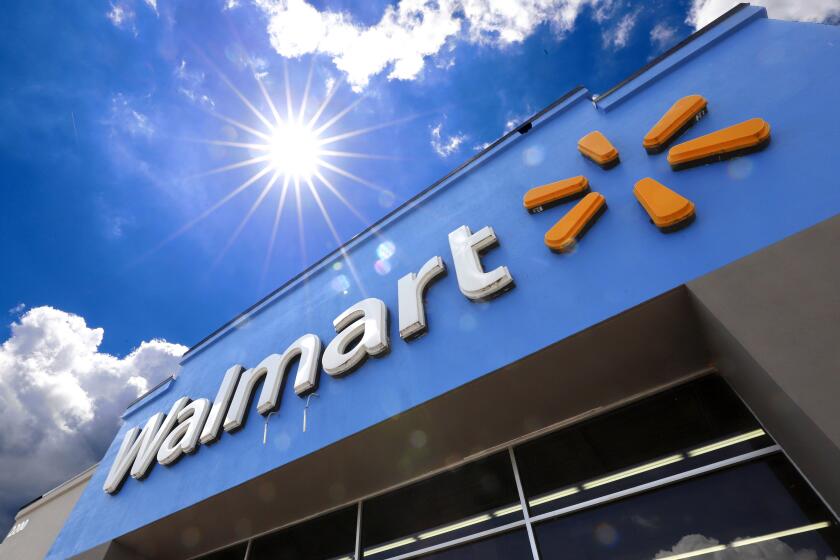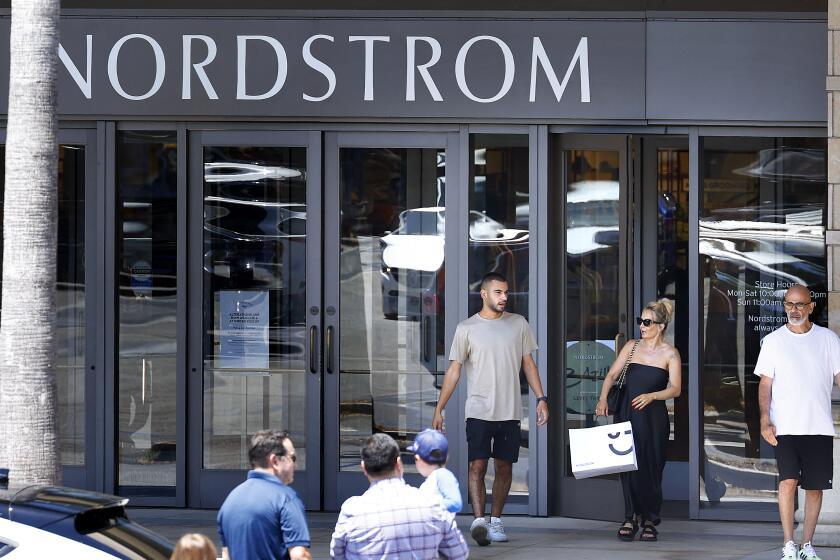A Toy Yoyo : Retailing: Galoob, which analysts say relies too much on a single product, is fighting back from an expected loss in 1990 after a record high in ’89.
- Share via
SOUTH SAN FRANCISCO — In the holiday season’s runaway hit film “Home Alone,” a youngster inadvertently left behind when the family goes on vacation uses his collection of Micro Machines to trip up a couple of bumbling burglars.
The scene is an apt metaphor for Lewis Galoob Toys Inc., which stumbled badly in 1990 when sales of its tiny planes, trucks and automobiles--a surprise sensation the two years before--dropped by nearly half, to a projected $75 million from $169 million in 1989.
When 1990 results come out next month, “it’s going to be a lousy year,” said David Galoob, who heads the small South San Francisco company founded by his parents 34 years ago.
Lousy begins to describe it. Analysts foresee a 1990 loss for Galoob of about $20 million, compared to a record profit of $19 million the year before.
Annual sales, meanwhile, have shriveled, with the L. H. Alton & Co. brokerage in San Francisco forecasting full-year revenue of $130 million, down from $228 million in 1989. And the price of Galoob shares, traded on the New York Stock Exchange, has sunk to $3 from a 52-week high of $13.375.
On top of its shabby financial performance, the company was bruised by a battle with Wall Street analysts, a 23% cut in staff, a court ruling preventing it from selling a hot new video game device and, just in time for Christmas, Federal Trade Commission allegations of false and deceptive advertising. (Rather than fight the complaint, Galoob agreed, without admitting wrongdoing, to refrain from issuing deceptive ads in the future.)
Like a kid on a teeter-totter, Lewis Galoob Toys keeps having its ups and downs, with 1990 a decided downer. Like other toy-company phenoms before it--Coleco, with Cabbage Patch dolls, and Worlds of Wonder, with the high-tech Teddy Ruxpin bear--Galoob is paying the price for relying too heavily on one product, industry observers say.
Whereas no one is predicting that Galoob will go the way of the others--into Chapter 11 bankruptcy protection--analysts foresee continued losses in 1991 and contend that the company faces a long struggle to dig its way out of trouble.
“The problem that Galoob has always had is it’s a one-product company, and every three years it’s a different product,” said Gary M. Jacobson, a research analyst with the Kidder, Peabody & Co. brokerage in New York. “It needs to establish a stable core of products to avoid the volatility of the past.”
Added Larry Carlat, editor of Toy & Hobby World magazine in New York: “Galoob is always on the precipice of the big time. But every time it has gotten close, the cigar has exploded in its face.”
Galoob, which last suffered a serious downturn in the retailing recession of 1987, wasn’t alone in having a wretched time in toyland last year. With the economy faltering and war fears heating up, consumers drastically cut spending. Meanwhile, toy retailers engaged in a messy holiday price war begun by the cash-starved Child World chain.
At Galoob, in particular, it seemed that everything that could go wrong did.
For starters, David Galoob, 41, president, chairman and chief executive, enraged industry analysts in presentations before last February’s Toy Fair in New York, the industry’s main event. He ridiculed them for not being upbeat about his company’s stock, given Galoob’s record performance in 1989. He predicted another stellar year.
But the new products Galoob showed did not catch fire. Alienated analysts urged clients to sell. The stock price tumbled.
“When you’re arrogant with the markets, . . . your stock will fall,” said Sean P. McGowan of Gerard Klauer Mattison & Co. in New York.
Of the experience, Galoob now acknowledges: “I am kind of rocky with Wall Street. I don’t play some of the games that other CEOs play. At least they (the analysts) are consistent--they haven’t liked me in bad years or good.”
In late February came the death of John Walker, a former Mattel Hot Wheels man who was the well-regarded product manager for Micro Machines, the tiny die-cast vehicles that go for $4 or $5 a set.
By mid-March, Galoob realized that sales of the product were slipping dramatically, with a glut of older models growing stale on store shelves and not enough innovative replacements in the pipeline.
In June, Galoob’s hopes for a blockbuster holiday product were zapped when a federal judge in San Francisco ordered Galoob to stop distributing Game Genie, a device that enables users to customize Nintendo video games.
Giant Nintendo of America had sued, maintaining that the item violated Nintendo’s copyrights. Although Galoob has appealed, it missed the crucial fourth-quarter selling period and lost out on what David Galoob contends could have been $100 million in sales.
When David Galoob revisited Wall Street at a brokerage firm’s toy industry conference in November, he was ready to acknowledge harsh realities and attempt to mend some fences.
“It was David Galoob starring in ‘Humble,’ ” Carlat said.
Despite the setbacks, David Galoob, the father of three boys who spend hours testing the company’s toys, remains optimistic for 1991. A wider range of products, he said, should help build a less volatile base in a business that thrives and dives on fads.
The company has beefed up and freshened the Micro Machines line, with new packaging, Macro Machines (on the scale of Matchbox and Hot Wheels) and tiny ships in bottles, a nod to David Galoob’s interest in collecting model ships, many of which adorn his office. (Micro Machines, which accounted for a whopping 74% of company sales in 1989, will close 1990 at somewhere between 55% and 60% of sales, the company said.)
In its earliest product introduction ever, Galoob has begun shipping Baby Face, dolls with different expressions and names such as So Surprised Suzie and So Happy Heidi. Galoob said it has had “large” orders for the $20 to $25 dolls.
The company also has what David Galoob calls a “couple of slam-dunks”: a line of wrestling figures to compete with Hasbro’s, and plush and other toys based on “Harry and the Hendersons,” a television series spinoff of a 1987 film about an injured bigfoot taken in by a suburban family.
The syndicated program won an unusually long 72-episode, three-year commitment from the Fox-owned television stations, where it was to have premiered Sunday. Galoob, a one-time film student at USC who dropped out to take over the business when his father died, said he is counting on the series’ planned longevity to boost sales.
Galoob acknowledges that the boom-and-bust cycle is no fun and that he would prefer the comfort of a more diversified product mix.
“We hate the roller-coaster ride. We despise it,” he said. “It makes for incredible stress.”
Besides, noted Galoob, who with options has 900,000 shares of stock, “my wealth is dramatically tied (to the company’s success). It’s directly in my interest to raise the stock price. . . . I was much happier when it was 14.”
More to Read
Inside the business of entertainment
The Wide Shot brings you news, analysis and insights on everything from streaming wars to production — and what it all means for the future.
You may occasionally receive promotional content from the Los Angeles Times.











